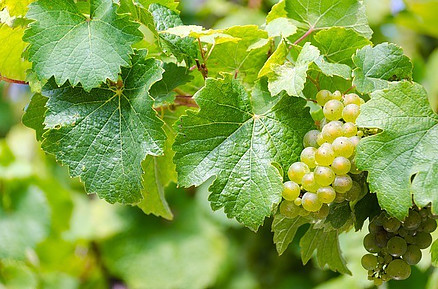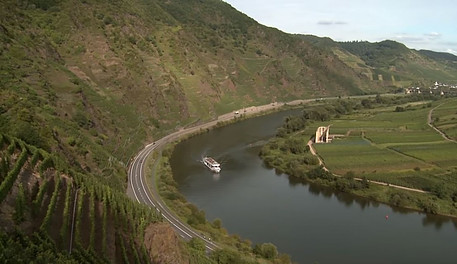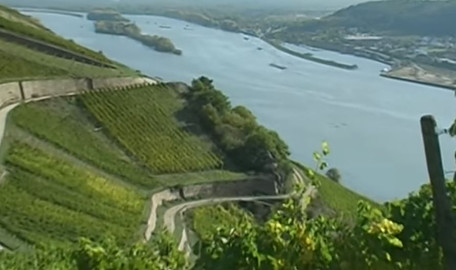Which is the best German wine? In Germany, vines have been cultivated since at least the fourth century, and its vineyards are among the world’s coolest, reaching above the 50th parallel, about as far north as grapes can grow. So winegrowing in Germany is a very special part of their agricultural industry. And it’s two-thirds white winegrowing and one-third red winegrowing. 
Is Riesling the Best German Wine?
Germany is home to almost half the world’s Riesling. Beloved for its versatility, elegance, and aging potential, it’s the country’s undisputed great grape. The Riesling grape, for them, is the most important grape variety. Riesling has so many faces, so many different variations, that you can do almost everything with it. You can have the Riesling very early after bottling, and you can age yourself with the wine up to 30, 40, 50, or 60 years. Riesling is also the best German wine you find in all their export countries. It’s a fantastic wine, a food-matching wine. It’s the most sophisticated white wine. And it’s the most versatile white wine. Outside Germany, consumers envision Riesling as a sweet wine. In reality, it can be made sparkling, off-dry, or lusciously sweet. But in fact, the majority of Riesling consumed in the domestic market is essentially dry. This diversity of style extends through the entire range of quality, from featherweight acidic plonk to the world’s greatest white wines. They have dry– very dry-styled wines, they have off-dry wines, and they have the sweet wines. And for each kind of taste, you can choose food.
It’s Not Easy to Know Which Is the Best German Wine
German culture has never erred toward simplicity, and its wine labels are no exception. The grape variety is typically noted on the label, but beyond that; things get cryptic for the consumer. 13 defined quality wine regions can be listed on the label. In addition, the village of origin and single-vineyard, or Einzellage, are often designated. Unfortunately for consumers, the most misleading exception in all of the wine law allows producers to use the name of a Grosslage, a large, expansive, mediocre-quality vineyard, in the same fashion as a single vineyard, with no easy way for consumers to discern the difference, other than inferring it from the price.
Winemaker’s Decision
The fundamental tenant of German wine law is ripeness at harvest, as measured by the specific gravity of the unfermented juice. Being a highly marginal climate, the origin of this approach makes some sense. The top-tier quality wines display a stated Prädikat, from Kabinett to Trockenbeerenauslese, assuring a minimum ripeness of the must. So sugar level in the grapes is given by weather and by nature. The sugar level in the wines is a decision made by the winemaker. Riesling sometimes is very thankful for having some residual sugar in the wine because the residual sugar, the sweetness in the wine, balances the fresh and crisp acidity of Riesling. But this is all about the winemaker’s decision. And they try to label their wines and indicate this to their customers.
VDP Is a Producer Organization Dedicated to Quality Wine
In addition to the label regulations defined by the country as a whole, many of Germany’s premier estates are members of the VDP, a producer organization dedicated to quality wine. The eagle on the bottle means that the VDP– that’s a special group of top estates in Germany. VDP, the Verband Prädikatsweingüter. This is the Fine Winemakers’ Association of Germany. It’s a membership association of 200 winemakers all over the 13 winegrowing areas of Germany. So you find good wines which are not in VDP, but to really select the crown of German winegrowing and winemaking, that’s VDP. >> (narrator)
The VDP defines its own rules and labeling terms, with a hierarchy of quality that applies to both dry and sweet wines. Frustratingly, VDP terminology has been in a state of flux for years. But recently, the organization has established a quality pyramid that drinkers of Burgundy would easily interpret.
It begins at the bottom with Gutswein. This is the very typical, basic wine – hence the term “good wine.” The second step is the Ortswein, where you get the growing dimension and get a bit more concrete. You have wines coming from a certain village, like Deidesheim, like Forst, like Ruppertsberg. The third layer is the Erste Lage, which describes excellent vineyard sites that already show a character independently. It’s not an ordinary field; it’s a vineyard with a character.
And the absolute pinnacle is the Grosse Lage, the grand cru of the VDP classification. These are the wines that really, like a lighthouse, radiate the image of the best German wines.
VDP members are only allowed to use Prädikats, such as Auslese, on sweet wines. Their dry wines in the highest category are technically only Qualitätswein under German wine law. Each of Germany’s 13 quality winegrowing regions, or Anbaugebiete, has distinct growing conditions and geography. But to understand the best German wine, it makes sense to start with the Mosel, the Rheingau, and the Pfalz.
Mosel – Fruity German Wines
Mosel, most of the wines are fruity and with residual sugar. And Rheingau, it’s kind of off-dry. And in Pfalz, it’s mainly dry. The valleys of the Mosel River and its tributaries comprise Germany’s most picturesque and iconic wine region. Mosel is the most picturesque part of Germany because of its very steep slopes. And it’s very hard work that winemakers do to cultivate these very steep vineyards.
The area in the middle Mosel, the best part of their region, is near the village of Brauneberg, on the most famous Juffer-Sonnenuhr. The Riesling needs special soil, a special microclimate. And the soil is essential; light soil, slates, loose slates, and the slates warm up very fast over the day, keeping the warmness over the night and sending it back to the wines.
Rheingau – Riesling Since the 1400s
Between the cities of Mainz and Wiesbaden, the north-flowing Rhine River takes a 30-kilometer westward turn. The south-facing vineyards along this stretch have been growing Riesling since the 1400s. There in the Rheingau, the first appearance of Spätlese is credited to Schloss Johannisberg in 1775. Today, the Rheingau continues to make long-lived sweet wines. But top vineyards there are even more renowned for dry wines. The Rheingau is the smallest of the three regions, with a little bit more than 3,000 hectares, but it’s the area with the highest percentage of Riesling growing. Rheingau is very easy. They have Riesling, 95%. And then, they have a little bit of Pinot Blanc.
And then they go into the red wine. They have some Spätburgunder, Pinot Noir. And that’s about it. The Rheingau wines are very well-known for their slightly salty and flinty minerality. Rheingau Riesling wines are always described as elegant, fresh, and crisp, with nice acidity, the good backbone of acidity, but also quite balanced because they have a lot of extract coming from the soil into their wines.
Pfalz – the Second Warmest Area in Germany
Just east of the French border, the Pfalz is home to the world’s most significant plantings of Riesling grapes, surpassing any other single country’s total acreage. The Pfalz is a strip along the Palatinate Forest 80 kilometers from north to south. It covers an area of about 10 to 15 kilometers, from the Palatinate Forest to the Rhine. It’s quite a mild and warm climate. It’s the second warmest area in Germany, which helps them ripen the grapes and reduce a bit of the acidity. Like Alsace, it’s neighbor to the southwest. The soil and topography of the faults can change dramatically from vineyard to vineyard. Millions of years of tectonic and volcanic activity mixed with an ancient riverbed to form a diverse soil landscape capable of yielding excellent wines from a range of different grapes. Compared with more northern regions like Rheingau and Mosel, wines from Pfalz have a much more fruit expression in wines. So you get more of that peachy, apricot flavor of the Riesling grape than compared with other regions.
Southern Pfalz – Share the Viticultural History with Alsace
In the southern Pfalz, you find a larger variety of grapes than in the north. This is where they share a viticultural history with Alsace. Here, you can find the entire Pinot family: Pinot Blanc, Pinot Gris, and Pinot Noir. You can also find other grape varieties: Gewürztraminer, Muscat.
Riesling is indeed just the beginning of what Germany has to offer. German winemakers are optimistic as they look ahead, confident in the uniqueness of their country’s terroir, climate, and grapes. I think the future will be bright. Riesling cannot be grown in too many parts of the world because Riesling always claims a special climate, cool climate, and special soil.
The Future of the Best German Wines Looks Promising
They have never had so many good winemakers – young, well-trained winemakers – as they do now. I believe that there will be even better quality in the future. Germany’s winemaking identity has evolved from ancient origin to widespread notoriety to diminished fame in the 20th century. Today, however, as wine lovers enthusiastically rediscover the best German wines and realize that they aren’t all sweet, the future looks promising.
